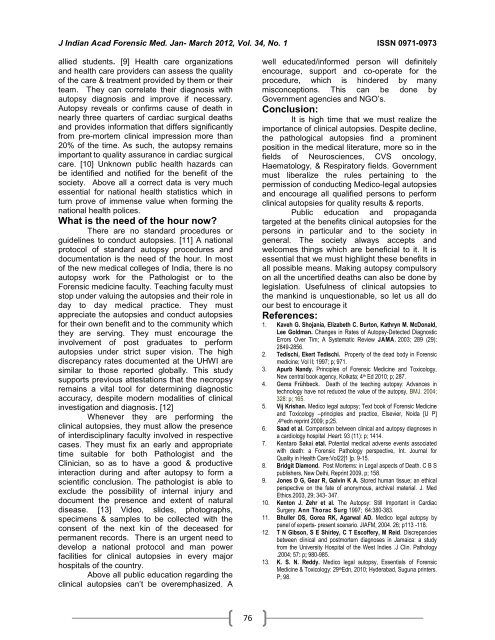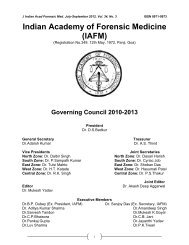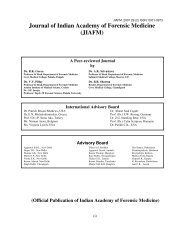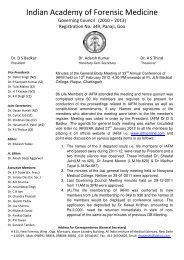Indian Academy of Forensic Medicine (IAFM) - Official website of IAFM
Indian Academy of Forensic Medicine (IAFM) - Official website of IAFM
Indian Academy of Forensic Medicine (IAFM) - Official website of IAFM
You also want an ePaper? Increase the reach of your titles
YUMPU automatically turns print PDFs into web optimized ePapers that Google loves.
J <strong>Indian</strong> Acad <strong>Forensic</strong> Med. Jan- March 2012, Vol. 34, No. 1 ISSN 0971-0973<br />
allied students. [9] Health care organizations<br />
and health care providers can assess the quality<br />
<strong>of</strong> the care & treatment provided by them or their<br />
team. They can correlate their diagnosis with<br />
autopsy diagnosis and improve if necessary.<br />
Autopsy reveals or confirms cause <strong>of</strong> death in<br />
nearly three quarters <strong>of</strong> cardiac surgical deaths<br />
and provides information that differs significantly<br />
from pre-mortem clinical impression more than<br />
20% <strong>of</strong> the time. As such, the autopsy remains<br />
important to quality assurance in cardiac surgical<br />
care. [10] Unknown public health hazards can<br />
be identified and notified for the benefit <strong>of</strong> the<br />
society. Above all a correct data is very much<br />
essential for national health statistics which in<br />
turn prove <strong>of</strong> immense value when forming the<br />
national health polices.<br />
What is the need <strong>of</strong> the hour now?<br />
There are no standard procedures or<br />
guidelines to conduct autopsies. [11] A national<br />
protocol <strong>of</strong> standard autopsy procedures and<br />
documentation is the need <strong>of</strong> the hour. In most<br />
<strong>of</strong> the new medical colleges <strong>of</strong> India, there is no<br />
autopsy work for the Pathologist or to the<br />
<strong>Forensic</strong> medicine faculty. Teaching faculty must<br />
stop under valuing the autopsies and their role in<br />
day to day medical practice. They must<br />
appreciate the autopsies and conduct autopsies<br />
for their own benefit and to the community which<br />
they are serving. They must encourage the<br />
involvement <strong>of</strong> post graduates to perform<br />
autopsies under strict super vision. The high<br />
discrepancy rates documented at the UHWI are<br />
similar to those reported globally. This study<br />
supports previous attestations that the necropsy<br />
remains a vital tool for determining diagnostic<br />
accuracy, despite modern modalities <strong>of</strong> clinical<br />
investigation and diagnosis. [12]<br />
Whenever they are performing the<br />
clinical autopsies, they must allow the presence<br />
<strong>of</strong> interdisciplinary faculty involved in respective<br />
cases. They must fix an early and appropriate<br />
time suitable for both Pathologist and the<br />
Clinician, so as to have a good & productive<br />
interaction during and after autopsy to form a<br />
scientific conclusion. The pathologist is able to<br />
exclude the possibility <strong>of</strong> internal injury and<br />
document the presence and extent <strong>of</strong> natural<br />
disease. [13] Video, slides, photographs,<br />
specimens & samples to be collected with the<br />
consent <strong>of</strong> the next kin <strong>of</strong> the deceased for<br />
permanent records. There is an urgent need to<br />
develop a national protocol and man power<br />
facilities for clinical autopsies in every major<br />
hospitals <strong>of</strong> the country.<br />
Above all public education regarding the<br />
clinical autopsies can’t be overemphasized. A<br />
76<br />
well educated/informed person will definitely<br />
encourage, support and co-operate for the<br />
procedure, which is hindered by many<br />
misconceptions. This can be done by<br />
Government agencies and NGO’s.<br />
Conclusion:<br />
It is high time that we must realize the<br />
importance <strong>of</strong> clinical autopsies. Despite decline,<br />
the pathological autopsies find a prominent<br />
position in the medical literature, more so in the<br />
fields <strong>of</strong> Neurosciences, CVS oncology,<br />
Haematology, & Respiratory fields. Government<br />
must liberalize the rules pertaining to the<br />
permission <strong>of</strong> conducting Medico-legal autopsies<br />
and encourage all qualified persons to perform<br />
clinical autopsies for quality results & reports.<br />
Public education and propaganda<br />
targeted at the benefits clinical autopsies for the<br />
persons in particular and to the society in<br />
general. The society always accepts and<br />
welcomes things which are beneficial to it. It is<br />
essential that we must highlight these benefits in<br />
all possible means. Making autopsy compulsory<br />
on all the uncertified deaths can also be done by<br />
legislation. Usefulness <strong>of</strong> clinical autopsies to<br />
the mankind is unquestionable, so let us all do<br />
our best to encourage it<br />
References:<br />
1. Kaveh G. Shojania, Elizabeth C. Burton, Kathryn M. McDonald,<br />
Lee Goldman. Changes in Rates <strong>of</strong> Autopsy-Detected Diagnostic<br />
Errors Over Tim; A Systematic Review JAMA. 2003; 289 (29):<br />
2849-2856.<br />
2. Tedischi, Ekert Tedischi. Property <strong>of</strong> the dead body in <strong>Forensic</strong><br />
medicine; Vol II; 1997; p; 971.<br />
3. Apurb Nandy. Principles <strong>of</strong> <strong>Forensic</strong> <strong>Medicine</strong> and Toxicology,<br />
New central book agency, Kolkata; 4 th Ed 2010; p; 287.<br />
4. Gema Frühbeck. Death <strong>of</strong> the teaching autopsy: Advances in<br />
technology have not reduced the value <strong>of</strong> the autopsy, BMJ. 2004;<br />
328: p; 165.<br />
5. Vij Krishan. Medico legal autopsy; Text book <strong>of</strong> <strong>Forensic</strong> <strong>Medicine</strong><br />
and Toxicology –principles and practice, Elsevier, Noida [U P]<br />
,4 th edn reprint 2009; p;25.<br />
6. Saad et al. Comparison between clinical and autopsy diagnoses in<br />
a cardiology hospital .Heart: 93 (11): p; 1414.<br />
7. Kentaro Sakai etal. Potential medical adverse events associated<br />
with death: a <strong>Forensic</strong> Pathology perspective, Int. Journal for<br />
Quality in Health Care:Vol22[1 ]p. 9-15.<br />
8. Bridgit Diamond. Post Mortems: in Legal aspects <strong>of</strong> Death. C B S<br />
publishers, New Delhi, Reprint 2009, p; 158.<br />
9. Jones D G, Gear R, Galvin K A. Stored human tissue; an ethical<br />
perspective on the fate <strong>of</strong> anonymous, archival material. J. Med<br />
Ethics.2003, 29; 343- 347.<br />
10. Kenton J. Zehr et al. The Autopsy: Still Important in Cardiac<br />
Surgery. Ann Thorac Surg 1997; 64:380-383.<br />
11. Bhuller DS, Gorea RK, Agarwal AD. Medico legal autopsy by<br />
panel <strong>of</strong> experts- present scenario. J<strong>IAFM</strong>, 2004. 26; p113 -118.<br />
12. T N Gibson, S E Shirley, C T Esc<strong>of</strong>fery, M Reid. Discrepancies<br />
between clinical and postmortem diagnoses in Jamaica: a study<br />
from the University Hospital <strong>of</strong> the West Indies .J Clin. Pathology<br />
.2004; 57: p; 980-985.<br />
13. K. S. N. Reddy. Medico legal autopsy, Essentials <strong>of</strong> <strong>Forensic</strong><br />
<strong>Medicine</strong> & Toxicology: 29 th Edn, 2010; Hyderabad, Suguna printers.<br />
P; 98.









